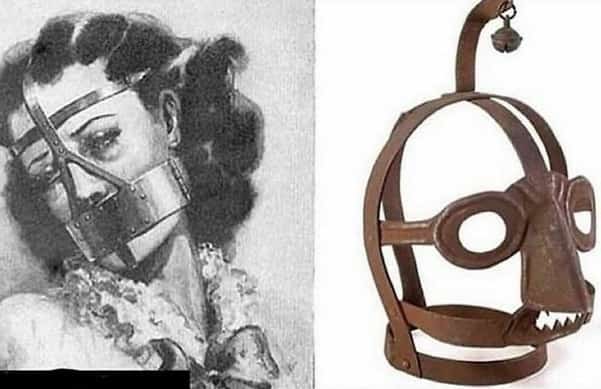Scold’s Bridle, The Torture Device Used To Silence Women In The Middle Ages

The Scold’s Bridle, also known as the “brank” or “gossip’s bridle,” is one of the more notorious punishments from medieval Europe, designed specifically to silence and humiliate women deemed to be too outspoken or disruptive. This iron device, used primarily between the 16th and 18th centuries, symbolizes a harsh form of social control that aimed to maintain order in patriarchal societies.
What Was the Scold’s Bridle?
The Scold’s Bridle was a metal cage or mask that encased a woman’s head. It typically included a gag or metal piece that was inserted into the mouth, often with spikes or rough edges to further discourage talking. The device was locked in place, leaving the wearer unable to speak or defend herself verbally. In many cases, the woman would be paraded around town, publicly shamed as a warning to others.
The name itself, “scold,” referred to a woman who was perceived to nag, argue, or criticize others—behavior that was seen as unacceptable, especially for women, during this time. This punishment was often used on women accused of gossiping, quarrelsome behavior, or being argumentative with their husbands or neighbors.
Origins and Historical Use
The Scold’s Bridle originated in Scotland and England but spread to other parts of Europe over time. It was used primarily in smaller, rural communities where maintaining social order was a priority. In such communities, gossip and outspoken women were often seen as threats to harmony and the power structure.
Unlike more violent punishments like flogging or execution, the Scold’s Bridle was intended to be humiliating rather than physically torturous—though the psychological torment could be immense. The wearing of this mask was a public spectacle, meant to degrade the woman in the eyes of her community, making her a symbol of what could happen if others did not conform to societal norms.
Symbolism and Social Control
The Scold’s Bridle reflected the deeply ingrained gender roles of the time, where women were expected to be submissive, silent, and obedient. The punishment reinforced the idea that a woman’s voice, if perceived as disruptive or challenging, could be controlled or silenced. In this sense, it served not just as a form of discipline, but as a symbol of male authority over women.
This method of punishment can also be seen as an early form of controlling free speech. While it was predominantly used on women, it was part of a larger system of social control that discouraged any behavior that went against the grain of societal expectations. The Scold’s Bridle was a tool that maintained the status quo, ensuring that dissent—especially from women—was not tolerated.
Variations of the Scold’s Bridle
Different regions had slightly varied designs for the Scold’s Bridle. Some versions included additional humiliations, such as bells attached to the device, which would ring as the woman walked, drawing even more attention to her punishment. Others incorporated sharper spikes or prongs that would dig into the tongue or the roof of the mouth, making even the slightest movement excruciating.
These devices were not universally used but were a more localized form of punishment. In many cases, they were employed by local magistrates or town leaders rather than through formal judicial processes, further emphasizing their role in community control.
Abolishment and Legacy
The use of the Scold’s Bridle began to decline in the 18th century, as legal reforms and changing societal attitudes toward punishment emerged. However, its legacy remains as a stark reminder of how women’s voices were often suppressed throughout history.
Today, examples of Scold’s Bridles can be found in museums, serving as a powerful symbol of the struggle for women’s rights and freedom of speech. These grim artifacts remind us of a time when speaking out could lead to public humiliation and torture.
The Modern Perspective
From a modern perspective, the Scold’s Bridle is seen as a grotesque relic of a misogynistic past. It reflects not only the punitive measures taken to silence women but also the broader cultural suppression of women’s voices. While society has progressed in terms of gender equality and the recognition of women’s rights, the Scold’s Bridle remains a chilling reminder of how power structures have historically sought to control marginalized voices.
In the contemporary world, the metaphorical silencing of women still occurs, albeit in more subtle ways. Recognizing the historical context of punishments like the Scold’s Bridle allows for a deeper understanding of how societal structures have evolved—and how they continue to shape our present.
A Historical Lesson in Silence and Control
The Scold’s Bridle is a harrowing reminder of the lengths to which societies have gone to control speech, particularly that of women. While the physical device may be a thing of the past, the cultural significance of silencing dissenting voices still resonates. Understanding this brutal punishment provides valuable insight into the historical struggles for freedom of speech and gender equality. As we continue to advocate for justice and fairness in society, lessons from the past remind us of the importance of protecting the right to speak freely without fear of retribution or humiliation.
FAQ: The Scold’s Bridle Punishment
1. What is a Scold’s Bridle?
The Scold’s Bridle was a medieval punishment device, usually made of iron, that encased a woman’s head. It was designed to silence her by placing a gag or metal bit in her mouth, preventing her from speaking. The device was primarily used on women accused of being too argumentative, gossipy, or outspoken.
2. Who was punished with the Scold’s Bridle?
The Scold’s Bridle was most commonly used on women who were labeled as “scolds,” meaning they were seen as nagging, quarrelsome, or gossiping. It targeted women who challenged societal norms by being overly vocal or disruptive in their communities.
3. Where was the Scold’s Bridle used?
The Scold’s Bridle was used primarily in England and Scotland, though it spread to other parts of Europe over time. It was more common in smaller, rural communities that wanted to maintain strict social control and preserve traditional gender roles.
4. Was the Scold’s Bridle painful?
While the Scold’s Bridle was not necessarily designed to cause extreme physical pain, it could be quite uncomfortable. Some versions had spikes or rough edges on the gag that would scrape the tongue or mouth if the wearer attempted to speak. The psychological torment and public humiliation were also significant aspects of the punishment.
5. How did the Scold’s Bridle work?
The device was locked around the woman’s head, with a metal gag placed inside her mouth to prevent speech. The wearer was often paraded through town, drawing attention from the public. In some cases, bells were attached to the bridle, making the punishment even more humiliating by alerting people to her presence.
6. Why was the Scold’s Bridle used?
The Scold’s Bridle was used as a way to control women who were perceived as disruptive, rebellious, or overly vocal. In patriarchal societies, women were expected to be obedient and silent, and those who didn’t conform were punished. The bridle was a tool to reinforce these strict gender norms and suppress women’s voices.
7. When did the use of the Scold’s Bridle decline?
The use of the Scold’s Bridle began to decline in the 18th century as attitudes toward punishment and women’s roles in society changed. Legal reforms, as well as evolving views on human rights and gender equality, led to the eventual abolishment of this form of punishment.
8. Is the Scold’s Bridle still used today?
No, the Scold’s Bridle is no longer in use. It is considered a relic of a more brutal and repressive past. Today, examples of Scold’s Bridles can be found in museums as historical artifacts that illustrate the oppression faced by women in earlier centuries.
9. What does the Scold’s Bridle symbolize today?
The Scold’s Bridle is a symbol of the historical suppression of women’s voices and the extreme measures taken to enforce gender roles. It serves as a reminder of the progress made in women’s rights and freedom of speech, but also highlights the ongoing struggle for gender equality and the fight against silencing marginalized voices.
10. Are there any surviving Scold’s Bridles?
Yes, there are several surviving examples of Scold’s Bridles, many of which are displayed in museums across Europe. These artifacts serve as powerful reminders of the harsh punishments used in the past and provide insight into the ways societies controlled behavior and speech, particularly among women.
